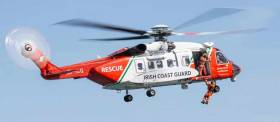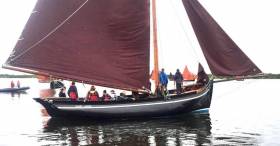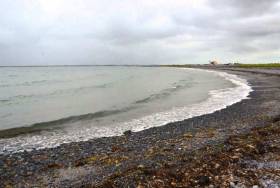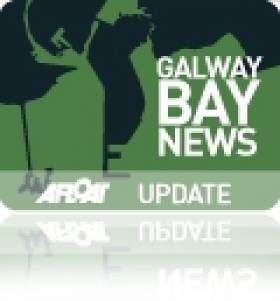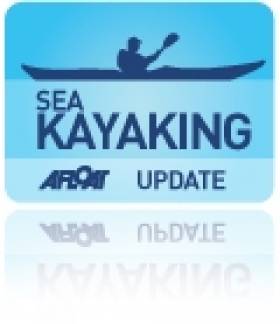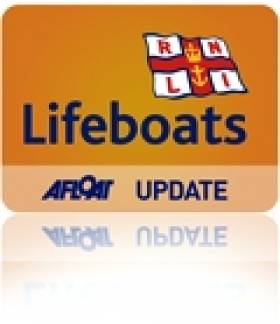Displaying items by tag: Kinvara
Candle-lit Boats Launched In Kinvara in Solidarity with Gaza
Candlelit paper boats were set adrift in the south Galway harbour of Kinvara late last week at a vigil hosted by the Kinvara Palestine Solidarity Group.
The event, entitled Caoineadh-Lament for Gaza, was held at dusk when many local people assembled at the pier.
Following a brief eulogy from Annie Rosario, a minute’s silence was observed, and then Eugene Lamb, a lone piper, played a lament that echoed across the harbour.
Finola Ó Siochrú sang “Cá bhfuil Mo Mhamaí?, a slow air she wrote to commemorate the children whose families have been killed in the conflict.
Over 27,000 Palestinians have been killed and over 66,000 wounded since Israel began its latest offensive in Gaza four months ago, according to the territory's health ministry.
Ó Siochru's air was followed by a chorus from a women’s group with local people joining in.
 Candlelit paper boats were set adrift in the dark, as people held a moment’s silence at Kinvara
Candlelit paper boats were set adrift in the dark, as people held a moment’s silence at Kinvara
Candlelit paper boats were then set adrift on the water, in the dark, as the people again held a moment’s silence.
The event was the latest in a series of solidarity vigils and peace marches held in Kinvara and Galway since October 7th.
During the Israeli war in Gaza in the summer of 2014, Kinvara residents and businesses took a collective stand against Israeli actions by pledging to support the growing boycott movement (known as BDS - Boycott, Divestment, Sanctions) against the state of Israel.
Man Taken From Car in Sea at Kinvara By Multi-Agency Rescue Effort
Combined marine, fire and ambulance services worked with local residents and the Garda to recover a man from the sea in south Galway last night after the car he was driving left the pier in Kinvara writes Lorna Siggins.
The man, believed to be in his late seventies, was taken to hospital in Galway city where he died overnight.
The alarm was raised after the car left the pier close to the south Galway village shortly after 8 pm on Thursday.
The Galway RNLI inshore lifeboat, the Irish Coast Guard Rescue 115 Shannon-based helicopter, National Ambulance Service and Galway city and Gort fire brigade units were tasked, while locals and a fishing vessel assisted in locating the vehicle in the water.
The man was taken from the vehicle at about 9 pm and attempts were made to resuscitate him before taking him to hospital in Galway by ambulance.
The Irish Coast Guard’s Doolin unit also despatched a rescue craft by road to the scene.
The car was lifted by crane from the water before 9.30 pm, and it was established that the man was the only occupant.
Colie Hernon and his family were setting the competitive pace over the weekend at the Crinniu na mBad in Kinvara, with the man himself winning the leath bad race with the 2012-built Croi an Cladaig, while his son Colie og Hernon was winner in the gleotogs with Nora Bheag writes W M Nixon.
The very handsome Croi an Cladaig featured here last week when we were previewing the annual festival, which in its modern form was founded by Tony Moylan in 1979 as a celebration of the western maritime and folk traditions.
 Croi an Cladaigh sailing in the kind of weather everyone had hoped for at the weekend, but it didn’t arrive. The superb sails were made in the west by Dara Baily.
Croi an Cladaigh sailing in the kind of weather everyone had hoped for at the weekend, but it didn’t arrive. The superb sails were made in the west by Dara Baily.
The sunlit image of Croi an Cladaig was so cheering that we were moved to put the most favourable possible spin on the weather predictions. That inspiring mainsail, by the way, was made in Connemara by Dara Bailey. But as our photos from the Pierces Purcell, father and son, clearly indicate, far from a brisk and sunny westerly, a huge crowd and a large fleet had to make do with rain and a fitful sou’east breeze.
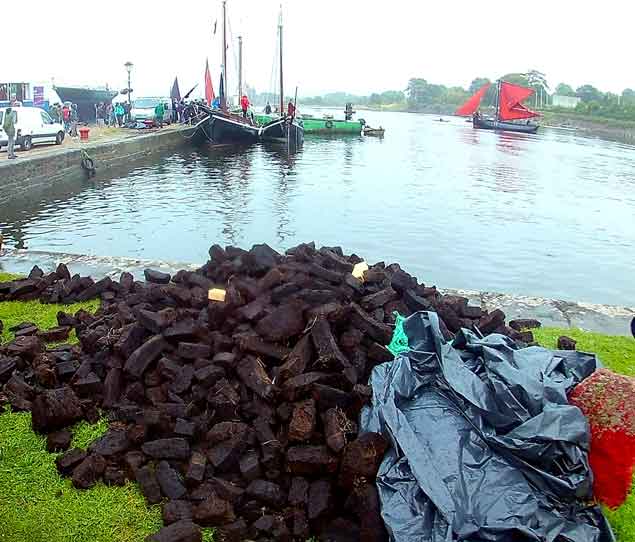 Part of the tradition is the delivery by hookers of the Connemara turf
Part of the tradition is the delivery by hookers of the Connemara turf
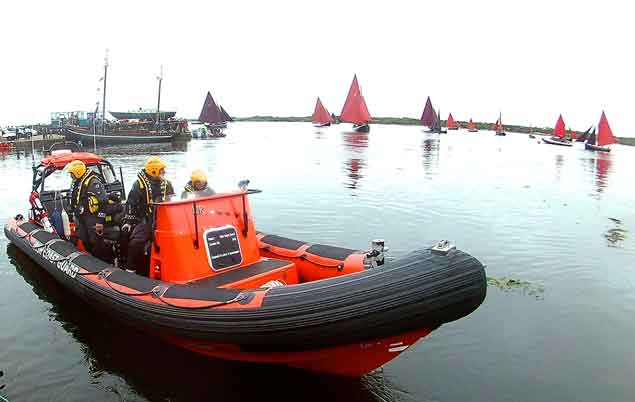 The Coastguard Service plays a key role in Galway Bay, and the local division were welcome guests at Kinvara
The Coastguard Service plays a key role in Galway Bay, and the local division were welcome guests at Kinvara
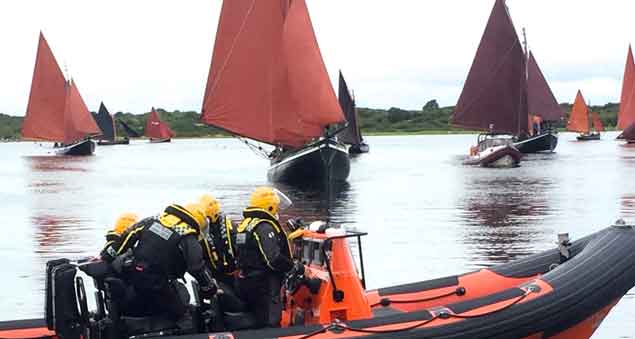 ….and they were able to get the best view of a slow-moving but fascinating race Yet the boats were so interesting and the onshore entertainments and food & drink experiences so many and varied that some who were there claim they didn’t notice any rain at all. Under the benign direction of Dr Michael Brogan it all went swimmingly, deliberately so in the case of those who took part in the time-honoured cross-harbour swim, and preferably not swimming at all for those who were in the in the seaweed boat race – don’t ask, the photo says it all.
….and they were able to get the best view of a slow-moving but fascinating race Yet the boats were so interesting and the onshore entertainments and food & drink experiences so many and varied that some who were there claim they didn’t notice any rain at all. Under the benign direction of Dr Michael Brogan it all went swimmingly, deliberately so in the case of those who took part in the time-honoured cross-harbour swim, and preferably not swimming at all for those who were in the in the seaweed boat race – don’t ask, the photo says it all.
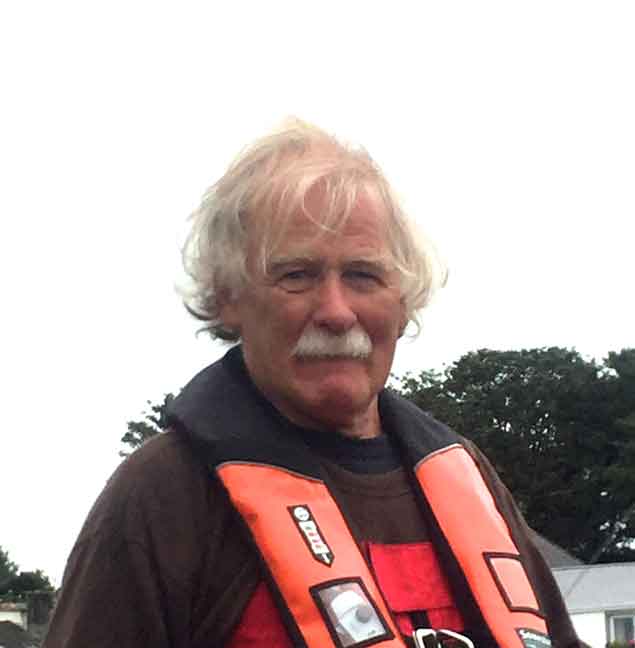 Dr Michael Brogan was the benign director of events
Dr Michael Brogan was the benign director of events
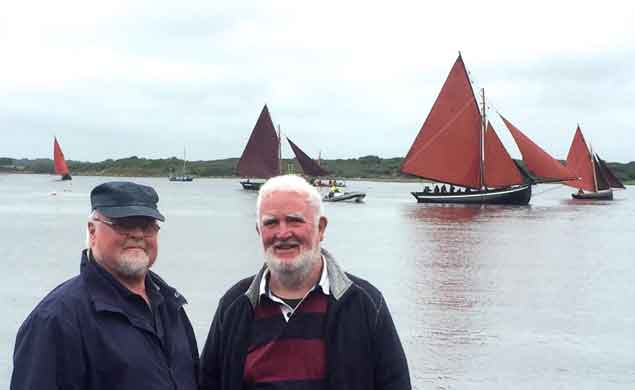 Men of the west – Pierce Purcell of Galway and Arctic voyager Jarlath Cunnane of Mayo at Kinvara
Men of the west – Pierce Purcell of Galway and Arctic voyager Jarlath Cunnane of Mayo at Kinvara
 “Rather you than me” – the traditional cross-harbour swimming race has some adhererents who have been involved from the start of the modern festival
“Rather you than me” – the traditional cross-harbour swimming race has some adhererents who have been involved from the start of the modern festival
 We don’t know if it’s a boat filled with seaweed, or a seaweed boat, but it definitely happens at Kinvara, and they race them
We don’t know if it’s a boat filled with seaweed, or a seaweed boat, but it definitely happens at Kinvara, and they race them
The requisite cargoes of traditional turf were on the Kinvara quayside from Connemara, and the inevitably slow racing began. The rest of the world thinks it is getting to grips with the nomenclature of Galway Bay’s traditional boats, but then those in the heart of it all move the goal-posts with a new category which we hadn’t heard of before, but doubtless it has been around since the time of St Brendan.
This is the gleotog mor, the “big gleotog”, which one expert assured us is somewhere between a leath bad and a bad mor. Thus in order of size we presumably ascend from the pucaun through the gleotog, the leath bad, the gleotog mor, and the bad mor which can go on to become something enormous like the Chicago-built, Atlantic-crossing Naomh Bairbre.
But exact categorization depends on so many factors that it’s not a topic for the faint-hearted, let alone the dim-witted, in which category we include ourselves when it comes to working out what’s what west of the Shannon.
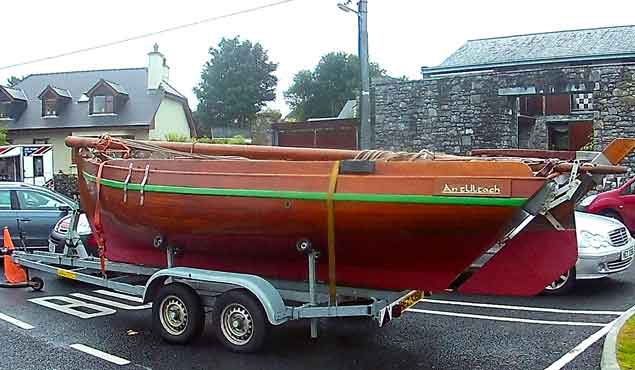 Is it a pucaun? Is it a gleotog? It depends on the size. And the rig. And other things…..This one had been road-trailed from the north. On a sunny day she might look orange, but she looked very brown on Sunday
Is it a pucaun? Is it a gleotog? It depends on the size. And the rig. And other things…..This one had been road-trailed from the north. On a sunny day she might look orange, but she looked very brown on Sunday
All we know is that every size was represented. There was even what looked like a pucaun road-trailed down from the north in a shade of brown through varnish which might look orange on a sunny day, but definitely looked brown in Sunday. And on the harbour in front of everyone was a traditional boat which seemed well on the way to becoming a yacht, for with her immaculate black topsides she sported a very stylish white boot-top at the forefoot to set off the blue anti-fouling.
The visual effect of a neat white boot-top, even a partial one, cannot be over-estimated – the great schooner Atlantic which was in Dun Laoghaire last week absolutely cried out for one, as she didn’t look her best with midnight blue topsides and dark grey anti-fouling with nothing in between.
But there in Kinvara was John Flaherty’s Naomh Cailin looking very well indeed with her white boot-top, and she was more than just good looks – she went out and won this gleotog mor class which is only just registering on our radar, and looked great doing it, with her Philip Watson sails settling in nicely as the breeze got a bit of life to it.
As for the really grown-up class, the bad mor division, that was won by the Tonai, skippered by Mairtin O’Brien. Yet again, the Kinvara gathering leaves us with a cascade of visions of unique boats - and unique people too. May it continue for ever.
 Kinvara’s Crinnui na mBad provides a cascade of visual memories to see everyone through to another year
Kinvara’s Crinnui na mBad provides a cascade of visual memories to see everyone through to another year
Lifeguards Rescue Father & Son Kayakers In Co Galway
#Rescue - A father and son were rescued on Thursday (21 July) by Kinvara beach lifeguards after being washed overboard from their kayak.
Lifeguards Mark Buckley and Niall Hanley contacted the Irish Coast Guard shortly after 3pm when they became concerned about two kayakers who had set out earlier from Traught beach.
Valentia Coast Guard immediately launched a search operation, tasking Galway Bay RNLI, the Shannon-based coastguard helicopter Rescue 115 and the Doolin Coast Guard unit.
Less than one hour after the alert was raised, Rescue 115 located the casualties. They were then recovered by Galway Bay lifeboat, who confirmed that casualties were safe and well.
The coastguard watch officers on duty in Valentia were highly complementary of the two local lifeguards, highlighting their vigilance, timeliness of their report and for piecing together information on the casualties.
Galway Bay RNLI were also complimented for the successful rescue.
Ireland's West Coast – Special Boats & Big Hearted Sailors
#historicboats – These days we're told of the growing disparity between the economic recovery of Ireland's eastern region, and the relative economic stagnation of some of the rest of the country. But W M Nixon suggests that, for one part of the western seaboard at least, there's a special vitality to life around boats which challenges this perception, and could usefully be emulated elsewhere. And he signs off with a thought-provoking conclusion.
Connemara, Conamara. Spell it as you wish, but The Land of the Sea on Connacht's most westerly coast fires the imagination and inspires the spirit. It's a place of the mind as much as a place of wild mountains where rocky inlets wind their way deep into rugged country. So while purists might define it exclusively as the much intertwined coastline with its myriad islands between Spiddal and Killary, many of the rest of us can be so inspired by that special Connemara quality that we reckon it runs all the way from Galway Bay to Achill. And anyone from that magic coastline, or indeed anyone who has been inspired by it, carries the spirit of Connemara with them wherever they may be.
The boat people you meet out there, each with their own unique and often ambitious maritime agenda, will send you on your way re-enthused about boats and places and their many possibilities. And when someone from another place or indeed another country decides that it's in Connemara their true self and fulfilment is to be found, far from being seen as exiles they are instead seen as a new focal points for their old groups, and their soul-mates from times past descend on them in Connemara for inspiration and mental re-birth.
This weekend, the boat men from Clondalkin in outer Dublin are journeying to Renvyle on the furthest far west coast to help one of their own in his boat restoration programme at a storm-battered corner on a bit of coast which was almost washed away in the winter's seemingly endless climatic violence.
The men of Clondalkin are the community group who built and sail and continue to lovingly maintain the large Galway Hooker Naomh Cronan. Recently, they've been busy enough with replacing some planks on their hefty big boat. But their key organiser Paul Keogh is mindful of the fact that one of their own, Paddy Murphy, is in the west, living on an Atlantic point out beyond the old Oliver St John Gogarty house which is now the hotel at Renvyle.
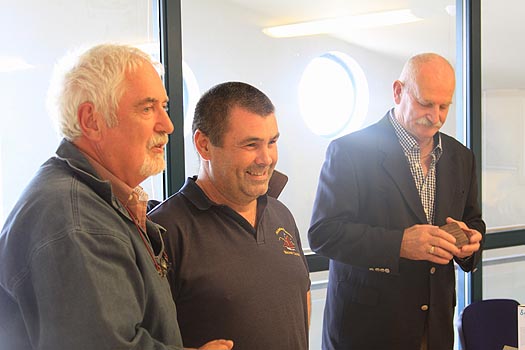
They dreamed the dream, and they made it happen. Key movers in the Naomh Cronan story were Stiophan O Laoire (left) and Paul Keogh, seen here at Poolbeg Y & BC as they come forward to accept a prize on behalf of the crew from Johnny Wedick, Hon. Sec. of the Dublin Bay OGA. Photo: Dave Owens
And between Paddy's house and the sea, beside a little hidden slipway which serves small boats which undertake the risky but rewarding challenge of harvesting Ireland's most fish-filled waters, the restoration project on the Aigh Vie is proving to be a demanding task. So this weekend the Keogh team – precise numbers unknown until everyone checks in this morning – are on site to re-caulk the Aigh Vie in a wild weekend of communal energy.
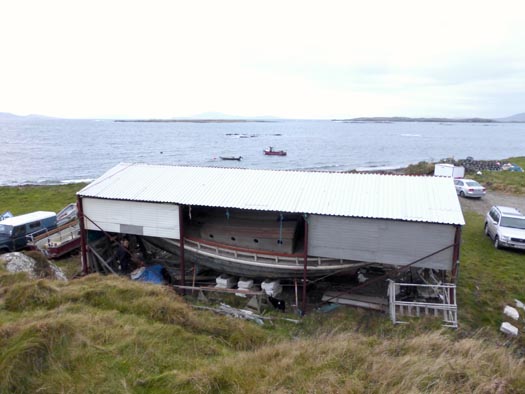
On the Atlantic frontier at Renvyle, the Aigh Vie is under her roof, tilted over to port to facilitate work under the starboard side of the hull. Photo: W M Nixon
For the Aigh Vie is one very special vessel. She's one of the Manx fishing nobbies which reached their ultimate state of development in the first twenty years of the 20th Century before steam power and then diesel engines took over. The nobby evolved to an almost yacht-like form through vessels like the 43ft White Heather (1904), which is owned and sailed under original-style standing lug rig by Mike Clark in the Isle of Man, and the 1910 Vervine Blossom, now based in Kinvara, which was restored by Mick Hunt of Howth, but he gave her a more easily-handled gaff ketch rig which looked very well indeed when she sailed in the Vigo to Dublin Tall Ships Race in 1998.
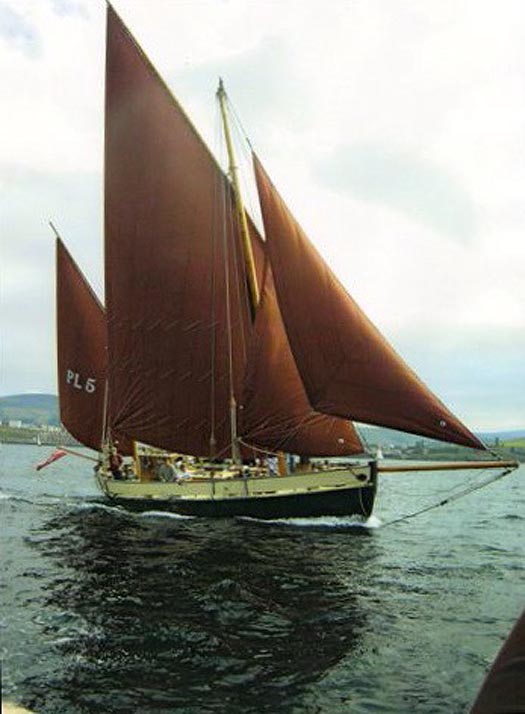
Mike Clark's Isle of Man-based 1904-built Manx nobby White Heather sets the original standing lug rig.
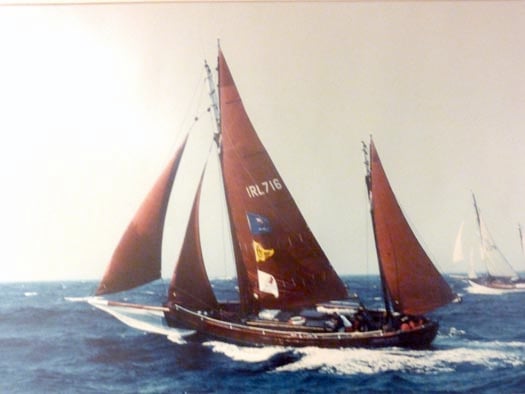
The 1910-built Manx nobby Vervine Blossom was restored by Mick Hunt in Howth, and is seen her making knots under her gaff ketch rig at the start of the 1998 Tall Ships Race from Vigo to Dublin. Photo: David Branigan
It takes quite something to outdo the provenance of these two fine vessels, but the story of Aigh Vie (it means a sort of mix of "good luck" and "fair winds" in Manx) is astonishing. It goes back to the sinking of the Lusitania by a German U Boat off the Cork coast in May 1915, when the first boat to mount a rescue was the Manx fishing ketch Wanderer from Peel, her crew of seven skippered by the 58-year-old William Ball.
They came upon a scene of developing carnage. Yet somehow, the little Wanderer managed to haul aboard and find space for 160 survivors, and provide them with succour and shelter as they made for port. In due course, as the enormity of the incident became clear, the achievement of the Wanderer's crew was to be recognised with a special medal presentation. And then William Ball, who had been an employee of the Wanderer's owner, received word that funds had been lodged with a lawyer in Peel on behalf of one of the American survivors he'd rescued. The money was to be used to underwrite the building of his own fishing boat, to be built in Peel to his personal specifications, and the result was his dreamship, the Aigh Vie, launched in 1916.
Over the years, the Aigh Vie became a much-loved feature of the Irish Sea fishing fleet. Tim Magennis, current President of the Dublin Bay Old Gaffers Association, well remembers her from his boyhood days in the fishing port of Ardglass on the County Down coast. In time, she was bought by the legendary Billy Smyth of Whiterock Boatyard in Strangford Lough, who gradually converted her to a Bermudan-rigged cruising ketch with a sheltering wheelhouse which enabled the Smyth family to make some notable cruises whatever the weather. His son Kenny Smyth, who now runs the boatyard with his brothers and is himself an ace helm in the local 29ft River Class, recalls that the seafaring Smyth family thought nothing of taking the Aigh Vie to the Orkneys at a time when the average Strangford Lough cruiser thought Tobermory the limit of reasonable ambitions.

Aigh Vie as she was when bought by Paddy Murphy from Billy Smyth of Strangford Lough.
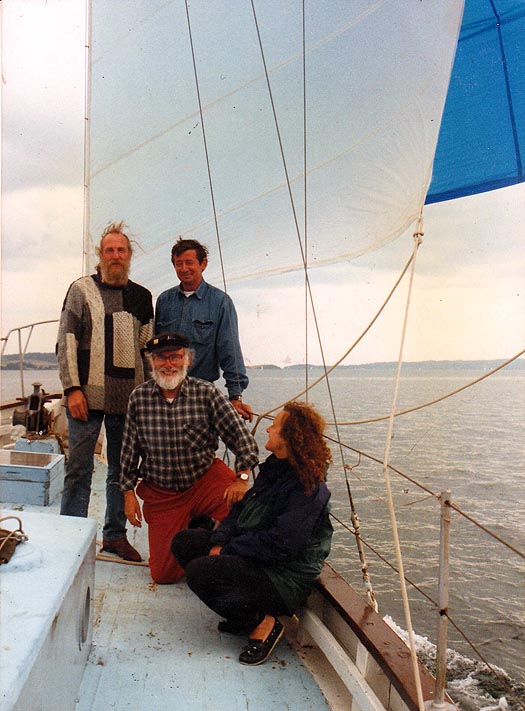
First sail with the newly-bought ship. Aboard Aig Vie heading for Dublin down Strangford Lough, the crew includes Paddy Murphy (left) and Tim Magennis (centre)
It's some years now since Paddy Murphy bought the Aigh Vie, and sailed her back to Dublin with his crew including Tim Magennis. But around the same time, Paddy was moving his base west to Renvyle, where he reckoned his skilled trade as a blacksmith, and his talents in traditional music and folklore, would provide him with a living in the area where he felt most at home.
As for the Aigh Vie, clearly she was reaching an age where work needed to be done. And he was minded to restore her to something more nearly approaching her original 1916 configuration. So somehow or other, he took the big boat west on a truck, managing to negotiate those little winding roads through Tully Cross and down to his place by the sea, where she went under a roof and work began.
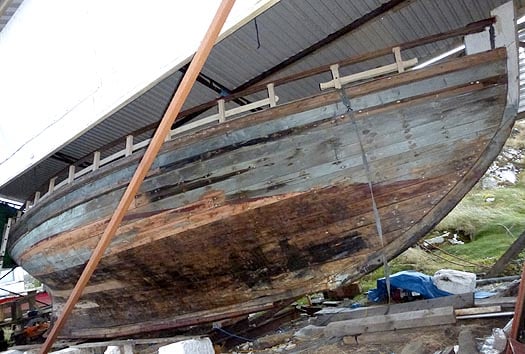
The hull of the 1916-built Aigh Vie as seen in Renvyle shows the remarkably yacht-like lines of the Manx nobby.........Photo: W M Nixon

.........in what was one of the last of the sailing type to be built before steam power took over. Photo: W M Nixon
It has been going on for some time now. The problem with being right on the frontier of Ireland's Atlantic weather is that no sooner do you start on some new area of timber repair and replacement, than the previous restoration section almost immediately starts to become weathered. Working largely on your own, you end up feeling you're going round in circles. So that's why the men from the Naomh Chronan are in Renvyle today to give the Aigh Vie project a mighty push forward.
For there's no doubt that while there's a lot done, there's a lot more still to do. But it does get done eventually if you keep the faith, and I was there back at the beginning of December to cheer Paddy along with all the usefulness of a hurler on the ditch. But at least I was accompanied by Dickie Gomes, who knows a thing or two about long-term boat restoration, as it took him 27 years to bring his 102-year-old Ainmara successfully back to life. But he did it so well that she won the Creek Inn Trophy for "Best in Show" at last summer's Peel Traditional Boat Weekend in the Isle of Man.

A bit of mutual support between two owners of vintage wooden boats – Paddy Murphy and Dickie Gomes in Aigh Vie's shed at Renvyle. Photo: W M Nixon
Nevertheless I've to confess that sometimes I wonder if wood is worth the trouble. Before getting to Renvyle, we'd called by with Jamie Young at Killary Adventure Centre for bit of a love-in with his alloy-built Frers 49 Killary Flyer which - as Brian Buchanan's Hesperia IV - was winner of the Round Ireland Race 1988 under the command of Dickie Gomes. Except that you won't see that fact in histories of the Round Ireland. Because for 1988's race, she sailed as the sponsored entry Woodchester Challenger, and thus was not entitled to the top prize, despite having the best corrected IOR time in the fleet.
But everyone in the know knows that Gomesie won, particularly the crew of Denis Doyle's slightly larger Frers sloop Moonduster. The two boats had been neck and neck running past the Blaskets, and suddenly Hesperia's spinnaker shredded. But Dickie had his crew so well drilled that one half of them had a replacement chute up and drawing before the other half had finished getting in the remains of the torn sail. The boat scarcely missed a beat in her rapid progress, and when the whole business was completed in about three minutes flat, there was a round of applause from Moonduster. You'd sportsmen doing the Round Ireland in those days.
As it happens, one of Hesperia's crew for that neat bit of work was Kenny Smyth, so it made it more than appropriate that we were going on to see the Aigh Vie on which he cut his offshore sailing teeth. But it was good to linger for a while at Jamie's snug place, and marvel at how he, with aid from the ingenious folk of the west, had contrived a slip and an angled trolley so that Killary Flyer can be hauled on site into a sheltered corner, for she's a big lump of a boat to be handling ashore.
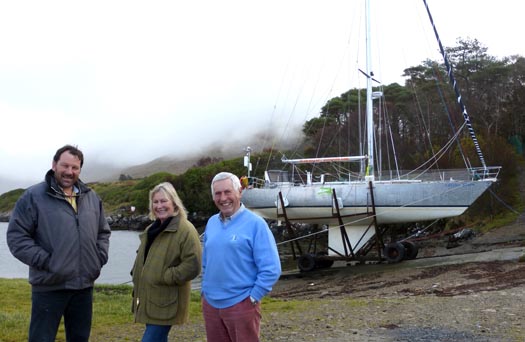
She's a big boat to be hauling on a slip in a remote corner of Mayo. Early December beside Killary Fjord, and Jamie Young of the Adventure Centre with Deirdre and Dickie Gomes and the Frers 49 Killary Flyer ashore for the winter. Deirdre was a fulltime member of the boat's crew when Dickie successfully skippered her offshore as Brian Buchanan's Hesperia IV. Photo: W M Nixon
It was some time in the New Year that we heard the shocking news. One of the most severe storms had twirled the Flyer up like a toy boat from her sheltered corner, and deposited this Frers masterpiece on her ear. Jammed in against the steep shore, she was trapped as the tide came in, and the hull was flooded with severe damage to the electrics and electronics.
But this is the west, where they're accustomed to overcoming massive challenges. The extraordinary Tom Moran of Clew Bay Boats played a key role in a salvage project which saw a temporary road being built so that a giant crane could be positioned for the delicate job of inching the big boat back upright. That done, she could then be moved to Tom's place at Westport for restoration to begin.
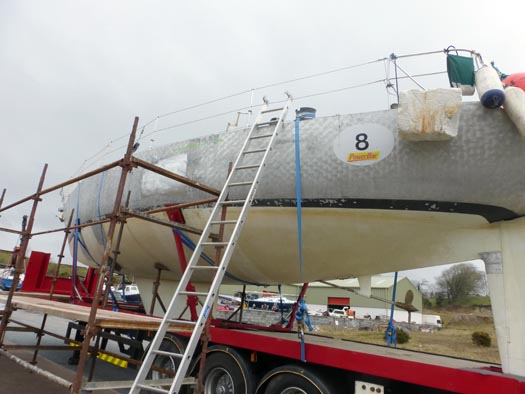
A couple of dents in aluminium? No problem. Following her brief episode of aviation, Killary Flyer's hull is already made good at Clew Bay Boats in Westport. Photo: W M Nixon
The whole business has been a marvellous advertisement for the effectiveness of hull construction using modern marine alloys. When aluminium was first created as the "Metal of the Future" two centuries ago, only the Emperor Napoleon could afford to have a cutlery set made in this exotic stuff. And though an early alloy boat put afloat in Lake Geneva performed reasonably well, as soon as a boat built with it was put into the salty sea, it just melted away.
But over the years the formulas have been adjusted to be corrosion proof in sea water, such that nowadays it's the ideal material for little boats which are going to have hard usage yet little maintenance, such as angling boats and the nippy craft used by rowing coaches.
And if you have a low-maintenance alloy hull yet give it a bit of cosmetic attention, it will look very well indeed, but it's not essential. As for the rough and tumble of life afloat, if you crash into a quay wall with a traditionally built wooden boat, she'll become shook from bow to stern – you never really know where the underlying structural damage ends, if at all. As for GRP and carbon or whatever, the damage will be more localised, but it still gets holed, and messily with it at that, while bulkheads may shift to an unknown degree
But a steel or aluminium hull will generally just be dented, and very locally at that. Repairs are manageable, even if it's skilled specialist work. So there's a lot in favour of steel and alloy. But steel rusts, and it never rusts quicker than in hidden pockets in the structure. But with remarkable advances in alloy welding and building techniques, the advantages of modern corrosion-free alloy construction become more evident every year for boats that are really going to be used, and not just seen as marina ornaments.
The Killary Flyer experience is ultimately a telling argument in favour of alloy construction. The hull was only dented in a couple of places where it was actually in direct contact with outcrops on the foreshore. Any dents have already been repaired by Tom Moran and his team, for they're able for anything to do with boats in any sort of material - I reckon if you wanted to build your dreamship out of resinated peat moss, then Tom would be game for the job.

Can-do people of the west – Mary and Tom Moran of Clew Bay Boats have successfully taken on many marine problems and projects. Photo: W M Nixon
Sorting out the interior systems is going to be more of a challenge, for Hesperia was originally Noryema X, built for Ron Amey in 1975. In a sense, there's a feeling of homecoming in the fact that she's being restored in Westport. If you head directly inland from that lovely little town, you're soon up in the mountains in the Joyce Country. And way back in 1975, the alloy hull of Noryema X was built by the renowned Joyce Brothers. Their fabrication workshop may have been in Southampton, but the family wasn't that long out of the mountains of far Mayo.
However, once the innovative Ron Amey had taken delivery of the hull of his latest Noryema from the brothers Joyce, he then took it to Moody's big shed at Bursledon on the Hamble for completion by the boatyard's craftsmen. I happened to be Bursledon-based in the early summer of 1975, and it really was all a wonder to behold.
Amey had installed a caravan in Moody's shed, and he lived in it while overseeing every detail of the new boat's fitout, while at the same time running his business empire of Amey Roadstone from a telephone in the caravan. It was said that the great man wouldn't be really happy with his new boats until the final jobs were completed just before the Fastnet Race in August, and after that he'd then start to think of the next one. But Noryema X was something special. She became the last of the racing line, and despite her enormous rig, Ron Amey then used her for eleven years of cruising in the Mediterranean which concluded with her sale to Brian Buchanan of Belfast Lough at Marseilles in 1986. She has been based on our island ever since, the source of much seagoing pleasure for hundreds of Irish sailors.
So bringing her back up to Amey standards is quite a challenge, as she's now part of Ireland's sailing heritage. But with Tom Moran they've someone who seems to have links with every maritime specialist in the country, and if he draws a blank in Ireland, his connections around the Solent marine industry seem pretty hot too.

Not quite where you'd expect to find an Arctic voyaging vessel, but Northabout seems at home in the Moylure Canal in the midst off Mayo fields. Photo: W M Nixon
Much encouraged by all this, for Clew Bay Boats is the sort of place where many good things seem possible, we then headed down to the Moylure Canal, a drainage waterway near Rosmoney at the head of Clew Bay where the great Jarlath Cunnane has created a tiny boat harbour and beside it a little place where, if so minded, he can build himself a boat.
Jarlath is the quintessential Connacht mariner, yet you'll never find him being sentimental about wooden boats. On the contrary, in the time I've known him he has built himself a steel van de Stadt 34ft sloop which he cruised very extensively, and more recently he took on the challenge of alloy construction to build the 44ft Northabout. Aboard this special boat, in teamwork with Paddy Barry, he has made cruises to remote and challenging places in voyages which, for most people, would have required full military logistical support.
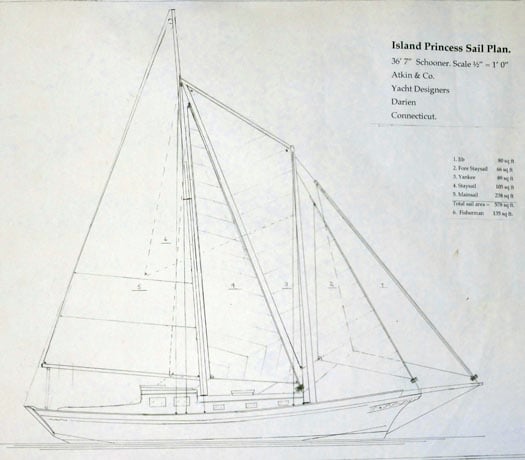
The new dreamship. Plans of the 37ft Atkins schooner which Jarlath Cunnane has been building over four years.
Knowing the scale of what he has done with her, it was bizarre to see Northabout sitting modestly in her berth in the little creek beside a Mayo field. But the presence of the long distance high latitude voyager was only part of the Moylure package. A few feet away in "the shed which isn't really a shed" was the new Cunnane boat, a sweet 37ft–Atkins schooner which, if you haven't yet appreciated the potential of good alloy boat construction, would surely win you over in a trice.

Good alloy construction, as seen here in the stemhead of the new schooner, can withstand comparison with any material. Photo: W M Nixon
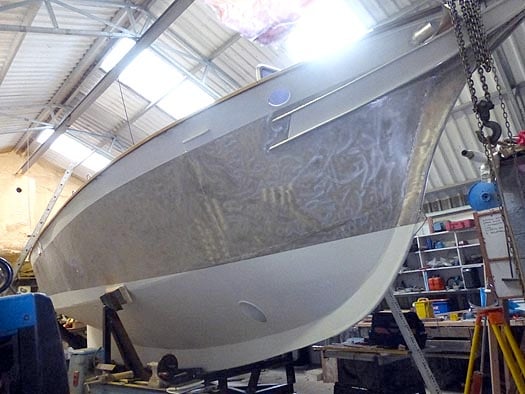
The new schooner has a workmanlike and handsome hull......Photo: W M Nixon

....which is aimed for comfort as much as speed, but she should be able to give a good account of herself in performance, and will be very comfortable for longterm periods on board. Photo: W M Nixon
Jarlath has taken four years on the construction, and when he gets to sailing the new boat, I'd say that the motto will be: "When God made time, he made a lot of it". This is a boat for leisurely cruising, a boat to enjoy simply being on board. In her finished state, she'll give little enough in the way of clues as to her basic construction material. Like Killary Flyer, and like Northabout too, she is in her own way a great advertisement for the potential of good alloy construction.
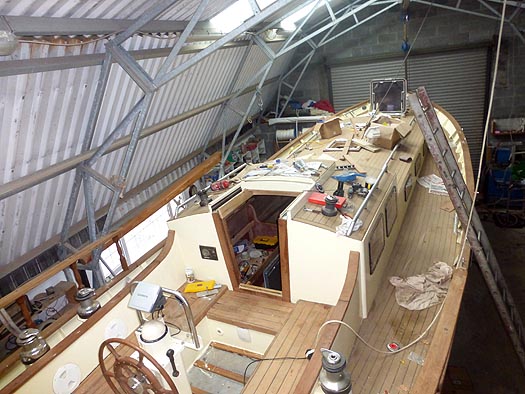
As completion nears, it becomes ever less apparent......Photo: W M Nixon
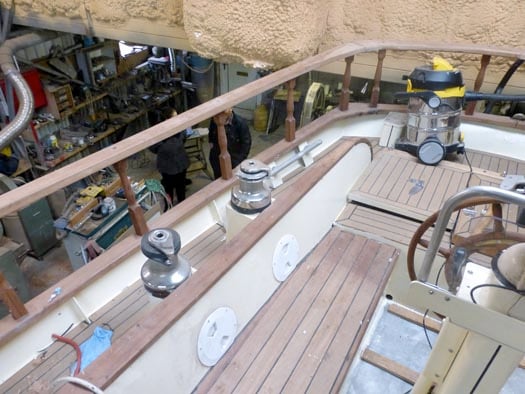
.....that the hull construction of the new schoner is in aluminium. Photo: W M Nixon
So we'll sign off this week with a special thought. As Irish life begins to move again, doubtless we'll soon hear increasing mutterings about the desirability of building a new Asgard sail training brigantine. Maybe we should keep the government out of it this time round, and build her through a voluntary trust organisation supported by public subscriptions and corporate donations. But however it's to be done, we should be starting to think about it.
And like many others, I've long thought that the ideal way forward would be with a steel hull built to Jack Tyrell's original Asgard II lines, which have a magnificently timeless quality to them. But I've changed my mind on that. Having seen what can be done with good alloy construction down in Mayo, and knowing the quality of alloy workboat construction being produced by firms like Mevagh Boatyard in Donegal and by the descendants of Jack Tyrrell among others at Arklow Marine Services in County Wicklow, it's difficult to escape the conclusion that the hull of the new ship should be built in aluminium.
It would be initially expensive, but it would confer great longterm maintenance advantages. And by going that way, we'd be able to provide all the double skins and safety bulkheads which will now be required without using up all available hull space, and without producing a boat so heavy she wouldn't be able to sail out of her own way. So let's hear it for an aluminium-hulled Asgard III.
Irish Cruising – Sailing's Magic Elixir for a Long Life
#cruising – Cruising is the hidden side of sailing, yet it's the choice for the majority of those going afloat. Whether it's day cruising, a longer venture in the annual holidays, or the dream cruise of a lifetime across oceans, this is our sport. Unlike racing, which generates its own narrative even if only through the recorded results, much of cruising would slip under the radar completely were it not for cruising awards. W M Nixon considers the latest annual batch from the Irish Cruising Club.
Cruising under sail seems to be the secret of eternal youth. Last night's Annual General Meeting of the Irish Cruising Club in Dun Laoghaire saw a distribution of awards to voyagers from all parts of Ireland who sailed successfully in many areas of the globe in boats mostly of modest size. Yet any outside analyst would soon have made the point that many of the achievers were of mature – sometimes very mature - years, and fulfilling a retirement dream.
But despite any ICC membership gathering these days being a sea of silver heads, age is the last thing they think about. This club of 550 members has become the mixture of an Active Retirement Association – very active indeed, as it happens – and a sort of seagoing extension of the Men's Shed movement.
If you were looking for an illustration of Ireland's changing demographics, and our very rapidly changing attitude as to what constitutes old age, you need look no further than the ICC. Time was when it was thought quite something when one of the club achieved the Golden Jubilee of their membership. But these days, it's no big deal to have been on the strength for fifty years, as the senior member is Joe FitzGerald of Crosshaven, who this year marks 70 years in the club, and he is closely followed by Douglas Mellon who joined in 1947 from Howth - he now lives on the Scottish Riviera in Kircudbright.
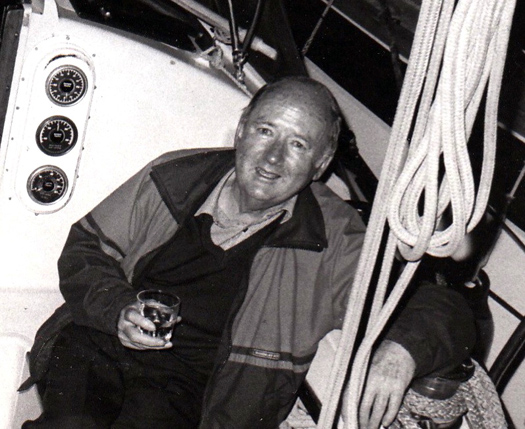
Joe FitzGerald of Cork is the ICC's most senior member, having joined in 1944. He served as Commodore from 1984 to 1987.
All those years ago when they took up their membership, it was thought perfectly normal for young men – married or otherwise - to take off for at least a fortnight's cruising every year, regardless of family demands which these days would be regarded as the prior commitment. In fact, nowadays so much emphasis is placed on family life and families doing just about every last recreational thing together, that younger married sailing people either do extremely short-hop cruising of the type necessitated by catering for the needs of all the members of the family, or else they don't cruise at all in the traditional sense - "Fun For All The Family" effectively rules out proper cruising.
Then too, modern life has so many other distractions - not least of them work demands which involve 24/7 attention - that the old-style easygoing simply-wandering-along holiday cruising is very much a minority activity. This means that at first it seems young people are not taking up traditional cruising at all. But with its deep experience garnered since its foundation in 1929, the Irish Cruising Club has learned to take the long view. It is not unduly concerned by the steadily rising age profile of its membership, and certainly every year there is a significant group of sometimes quite senior yet nevertheless increasingly active cruising enthusiasts joining the club.
They're the embodiment of the slogan that Sailing is a Sport for Life, and it's only politeness which prevents them saying that the subtle pleasures of cruising are wasted on the young. So when you look at the lineup of achievement represented by last night's awards, it's natural to wonder what these people did in earlier life, that they can nowadays afford the time, resources and dedication necessary to complete voyages of this quality.
The adjudication was done by Dave Whitehead of Kinvara on Galway Bay, himself no stranger to the ways of the sea while making long voyages in small craft. He breaks new ground by awarding three trophies at once to Sam Davis of Strangford Lough, whose Cape Horn and Pacific ventures with his Rival 41 Suvretta have been quietly bubbling away in the background of ICC activity for the past three years.
Sam Davis first featured in Afloat magazine in March and April 1981 when we ran his two-part account of his first ocean voyage, an Atlantic circuit from Strangford Lough between 1976 and 1979 with the 34.5ft West Solent Class Suvretta, a former racing boat he'd found in a derelict state and restored to ocean-going condition.

The 34ft West Solent class Suvretta in her offshore racing days in the 1950s when she was based in Belfast Lough. When Sam Davis did the Atlantic Circuit cruise with her in 1976-79, she carried a less loft mainmast, with masthead rig.
But even with Sam's improvements, she was still no more than a slip of a boat, so it says much for his grit and skill that he brought her through the Fastnet storm of 1979 as he sailed the final hundred miles back to Ireland. There was damage aloft, and he'd to get into Dunmore East unaided with jury rigging, but the job was done.
While in the Caribbean, he'd worked in charter yachts between times to make a shilling or two. But after he'd spent time back in Northern Ireland, he went abroad into serious seafaring in offshore service industries, working in places like The Gulf, the North Sea, the Amazon, the Red Sea and Malaysia, becoming a fully accredited Marine Consultant.
Yet if you ask him nowadays what he is and what he was, he'll say he's a farmer and former seaman, as his purchase some years ago of Conly Island in Strangford Lough (you can drive out to it when the tide is down) gives him the little bit of land, and an anchorage too, while "seaman" covers his many experiences in offshore work.
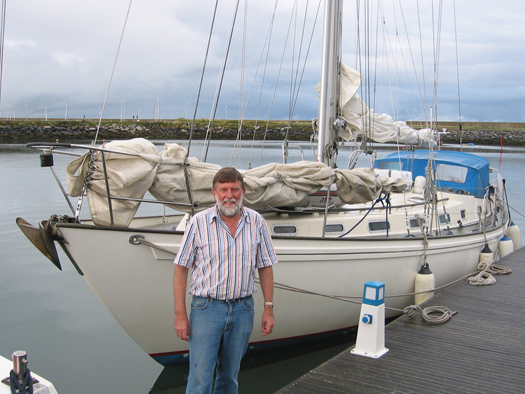
Sam Davis with his newly-acquired Rival 41, re-named Suvretta, in 2009. Photo: W M Nixon

Suvretta in the Beagle Channel in southern Chile. Photo: Sam Davis
Back in 2009 he bought a Rival 41, a hefty and able vessel, a sister-ship of Waxwing in which fellow ICC members Peter and Susan Gray of Dun Laoghaire went round the world 14 years ago. Sam re-named his new boat Suvretta, spent the winter sorting her out, and in 2010 he was gone, sailing south single-handed to eventually round Cape Horn and then spend a long time on the coast of Chile. He was delayed there as a ship broke drift and damaged the boat, but it was well fixed, and he voyaged on into the Pacific to many islands, including Pitcairn and the Tahiti group.
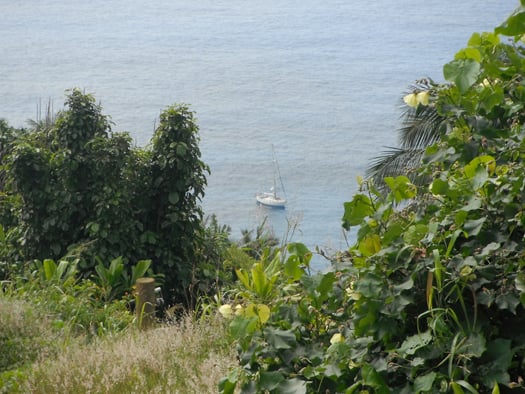
Restless anchorage. Suvretta in Bounty Bay on Pitcairn Island. Photo: Sam Davis
Eventually he fetched up for some time in Tonga, where he became enthused about the 73ft Vakas, the Pacific islanders' contemporary take on the classic Polynesian inter-island vessels (see Sailing on Saturday 11th January 2014). But by November 2012 it was time to head for home, so Suvretta sailed southeast for Cape Horn non-stop, and having rounded it, shaped her course for Port Stanley in the Falklands.
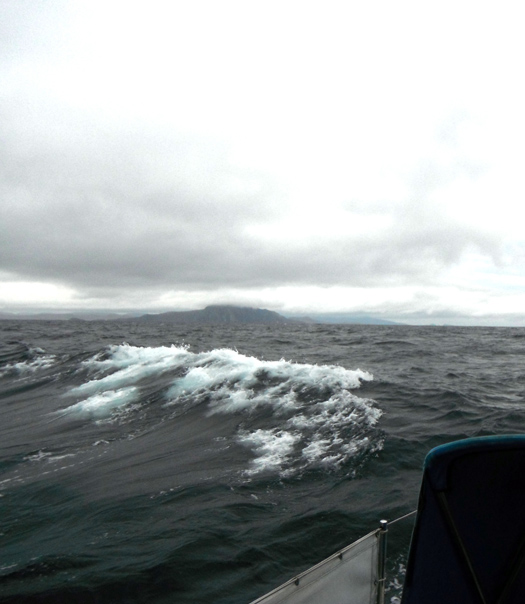
Suvretta rounding Cape Horn for the second time, 21st January 2013. It was only when the Horn was well astern that the weather deteriorated rapidly to make for a challenging approach to Port Stanley. Photo: Sam Davis
However, while rounding the Horn had been simple enough, the passage onwards to Stanley became increasingly fraught, running before rising storm force winds. Conditions were such that it looked for a while as though the lone sailor was going to be swept right past the islands, but he made the cut into shelter to such a nicety that he is awarded the ICC's Rockabill Trophy for Seamanship.
And then when Port Stanley was reached, a very fine passage had been completed from Tonga, so last night for that he was additionally awarded the ICC's Atlantic Trophy for the best voyage with a non-stop leg of more than a thousand miles. And then finally, after they'd spent the mid part of 2013 working their way up the Atlantic with the lone skipper particularly enjoying himself at ports on the Irish coast, Suvretta and Sam returned after three years to Conly Island. And they'd now done more than enough to also be awarded a third trophy - the ICC's premier honour, the Faulkner Cup.
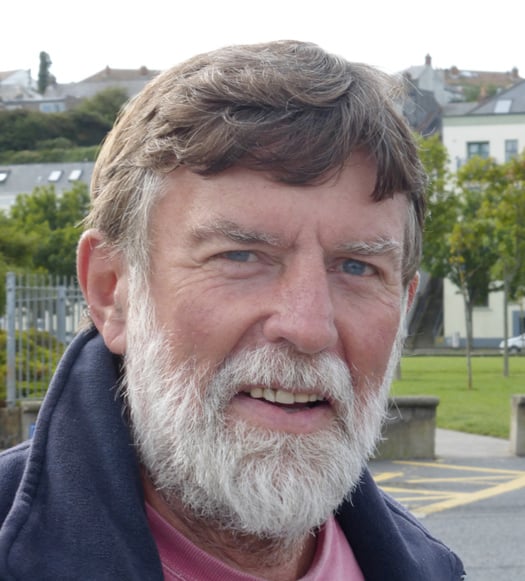
Home again. Sam Davis back in Ireland, August 2013. Photo: W M Nixon
With such a high level of activity by many members, ICC adjudicators always find some final choices to be a very close call, so some years ago the Strangford Cup was inaugurated for the cruise which almost won the Faulkner Cup. This year it has gone to a fine cruise from Portugal to Madeira and through the Azores in detail before returning to Portugal.
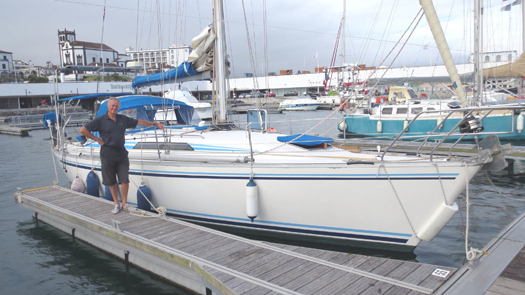
John Duggan with his MG CS40 Hecuba in Horta in the Azores
John Duggan originally hailed from Malahide where he sailed, and he also sailed with the college teams while at Trinity College in Dublin. He cruised and raced offshore mostly in the Irish Sea, but having qualified as an accountant he decided to spread his wings internationally, and he became one of those key people who turn up as partners in one of the big four accountancy firms worldwide.
Eventually his career brought him to the company's offices in Lisbon. Living in Portugal suited him fine, so he put down roots and in time bought himself an interesting cruiser. Hecuba is a 1989 Canadian-built Tony Castro-designed MG CS40, a handsome 12m craft with good performance enhanced by an effective wing keel.
During his final years in the day job he gradually improved the boat with a mind to some proper cruising once he retired at 60, something which he planned with all a high-powered accountant's meticulous attention to detail. He remembers the final day at the office, when a friend on the other side of the world sent him an email: "Even the worst day of your retirement will be better than the best day at work".

Azorean whaleboat with Pico beyond seen during one of Hecuba's cruises from Portugal to the Azores. Photo: John Duggan
Maybe so, yet not everyone makes the changeover smoothly, but in John Duggan's case the challenge of planning and executing remarkably civilised yet challenging cruises has proven to be a complete new job in itself, but much more fun than number crunching. He goes to enormous trouble to make sure that his crews have as enjoyable and varied an experience as possible, yet all the time he is quietly keeping the project moving along while noting details and features of ports visited which might be of interest to fellow skippers, a habit which is the hallmark of the true cruising man.
When you live in Cascais with your boat based in the marina nearby, the Azores are the western isles which call you each summer. But unlike Scotland's Western Isles which are just a day's sail away across the Sea of the Hebrides, the Azores involve an immediate ocean voyage from Portugal of at least 500 miles. However, for 2013's cruise west, Hecuba made it a triangle, going first to Madeira before going on nor'west to the Azores which were cruised in detail before returning to Cascais after six weeks away, having logged 2390 miles, with the final tabulation being:
Hours spent close hauled: Zero.
Cross words exchanged: Zero.
Inevitably the two big awards dominate the scoresheet, but the ICC also has a host of trophies which reflect every level of club sailing activity. The Round Ireland Cup, for instance, is for the circuit which produces most information for the club's sailing directions, and in a year in which a goodly number went round, it was Donal Walsh of Dungarvan with his Moody 31 Lady Kate who best filled the bill.

Donal Walsh's Lady Kate anchored at Inishmurray off the Sligo coast during his detailed round Ireland cruise. Photo: Donal Walsh
As the Faulkner Cup was first won in 1931 by the 28ft cutter Marie, the Marie Trophy is for the best cruise by a boat under 30ft, and Mick Delap from Valentia Island with his Tamarisk 24 gaff cutter North Star fits into the size requirement with six feet to spare. He made a fine job of completing a two-summer circuit of Ireland by returning from western Scotland via the Irish Sea and Ireland's south and southwest coasts.

Mick Delap's Tamarisk 24 North Star from Valentia in Lowlandman's Bay in Jura in the Hebrides. Photo: Mick Delap
In all, the ICC has a dozen cruising trophies. But even so not everyone gets one in a typically busy year, so to encourage the newcomers they've the Perry Greer Trophy for first time log-writers, and it goes to Peter Mullan from the Quoile in Strangford Lough for his insightful account of a round Ireland cruise with the Jeanneau Sun Odyssey Sancerre.
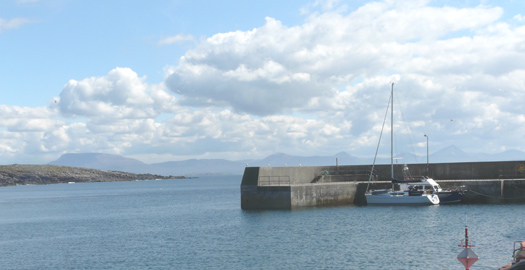
Peter Mullan's Sun Odyssey Sancerre in the little harbour at Tory Island with the Donegal highlands beyond. Photo: Peter Mullan
All the logs, including the winning ones, were featured in the ICC's 180-page Annual 2013, which Honorary Editor Ed Wheeler managed to get to the members in time for Christmas. All this is done by voluntary effort, yet the Annual would stand up to professional comparisons, as it includes informative accounts of cruises in just about every part of the world, plus a report on the ICC Cruise-in-Company to the Isles of Scilly which was an outstanding success despite coinciding with some uneven weather in June.
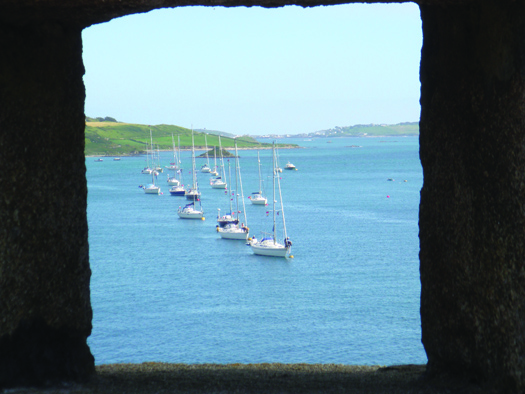
The Irish Cruising Club flotilla in the Isles of Scilly during their successful Cruise-in-Company in June 2013.

Everyone to his taste. ICC member Brian Black went to Greenland for the sixth time, crewing on Aurora. This is Kangertitiatsivaq Fjord in high summer. Photo: Brian Black
There's more to the Club than the Annual, as the ICC's programme of producing constantly up-dated Sailing Directions for the entire Irish coast in two volumes is a continuous progression, with the latest 12th Edition of the North & East Coast Book due next month from Honorary Editor Norman Kean, whose home port is Courtmacsherry.
Thus it's clear that Ireland's cruising club is a truly all-Ireland organisation, and this year it will be celebrating its 85th birthday with a Cruise-in-Company to Glengarriff where it was founded on July 13th 1929. Yet despite its obvious significance, this is a club without premises. In the final analysis, it's a club of the mind, made up of kindred spirits. Heading such a body is a mighty challenge, and the changing of the watch is always a charged moment.
Last night David Tucker of Kinsale stood down after serving his three years as Commodore, and he was succeeded by Peter Killen of Malahide. His experience in club administration is long-lived – he was Commodore of Malahide YC when it became "Club of the Year" in 1980. But it was his cruising CV which next went into overdrive, as in 1993 he voyaged north to Iceland, circled it, and then sailed back in near-record time in an S&S 30. He then moved up to a Sigma 36 which he cruised to Greenland among other places, following which he cruised even further with a Sweden 38, and then in 2004 he took on his dreamship, the Amel Maramu 54 Pure Magic.
Peter Killen seems to have cruised this very special boat just about everywhere. Not least was deep into Antarctica, where he made a memorable arrival in zero visibility with icy conditions into the natural harbour in the extinct volcanic crater on Deception Island. It was all a long way in time and distance from five boats gathered in Glengarrif in the hope of forming a little cruising organisation back in 1929. But that's the way it is with the Irish Cruising Club.
Search For Galway Man Extends To Coastal Areas
#GalwayBay - Galway Bay FM reports that the search for a missing Galway man has been expanded to a coastal search.
Tom Ward, 39, was last seen in Galway city centre on 7 February, and was reported missing by his family 10 days later.
Gardaí stepped up their search to the shoreline areas of Galway Bay adjoining the city earlier this week, enlisting Civil Defence volunteers to search as far as Kinvara in the south-east corner of the bay.
Night Sea Kayaking Trips on Kinvara Bay This Winter
#SEA KAYAKING - Outdoors Ireland are running night-time sea kayaking trips on Kinvara Bay on Friday evenings over this winter and spring.
Beginning at 6pm each Friday, you can savour the sights, lights and sounds of Kinvara right on the water as you paddle by sea kayak through this southeastern corner of Galway Bay.
Paddle among deserted islands, listening to the abundant wildlife and possibly catching a glimpse of the gleaming eyes of friendly seals!
Moreover, witness the sight of the sparkling lights of Kinvara Town and the quietly impressive 16th-century Dungaire Castle.
With new sea kayaks, warm equipment provided and a local experienced guide, all abilities are catered for. This is an experience not to be missed next time you are in Galway.
The price is €50 per person for a three-hour kayak trip. For more details or photos please contact [email protected] or 086 860 4563.
Retire to a Country Farm with Views from Bay to Burren
#WATERFRONT PROPERTY - Anyone thinking of retiring to the country life should be more than a little tempted by Poppy Lane, a residential farm on the southern shore of Galway Bay now on the market.
Irish Independent Farming reports on the 72-acre property at Killeen Hugh, just four miles from Kinvara and 17 miles from Galway City, with ruggedly beautiful views from the Burren to the sea.
The land consists of mostly fertile ground with no buildings, with water supplied via a private well, with the adjacent traditional four-bed farmhouse has been refurbished in recent years, with oak floors and solid doors.
Agents Keane Mahony Smith have set a guide price of €225,000 for the house and €7,500/acre for the land, with the property also available in lots including the land or the house on their own.
More details of the properly, including images, are available HERE.
Woman and Child Rescued from Stranded Dinghy in Kinvara
#LIFEBOAT - The Galway Advertiser reports that the Galway RNLI lifeboat came to the rescue of a mother and child from a small dinghy near Kinvara in the south-eastern corner of Galway Bay yesterday.
High winds and an offshore breeze caused the dingy to drift onto Mulrooney Island between Kinvara and Parkmore Pier, stranding the Dublin woman and her four-year-old son, who are holidaying in the area.
The lifeboat crew were dispatched to the scene by the Irish Coast Guard after being notified by a canoeist in the area who assisted the family. Both were wearing lifejackets at the time of the incident, and were taken back to shore unharmed.



























